4.1 Sex Is Determined by a Number of Different Mechanisms
Sexual reproduction is the formation of offspring that are genetically distinct from their parents; most often, two parents contribute genes to their offspring and the genes are assorted into new combinations through meiosis. Among most eukaryotes, sexual reproduction consists of two processes that lead to an alternation of haploid and diploid cells: meiosis produces haploid gametes (spores in plants), and fertilization produces diploid zygotes (Figure 4.3).
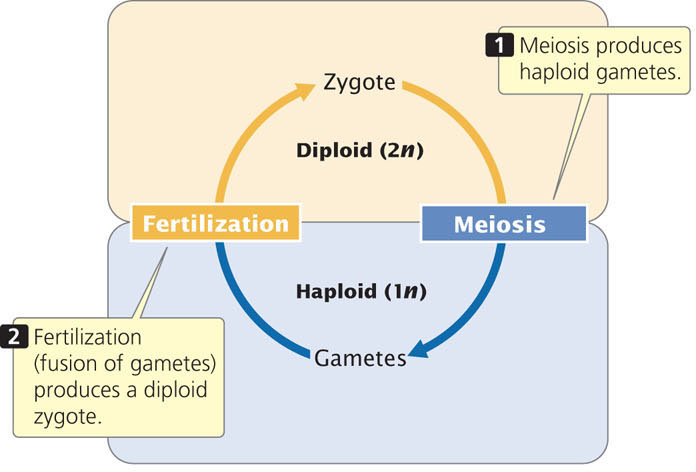
The term sex refers to sexual phenotype. Most organisms have only two sexual phenotypes: male and female. The fundamental difference between males and females is gamete size: males produce small gametes; females produce relatively larger gametes (Figure 4.4).

The mechanism by which sex is established is termed sex determination. We define the sex of an individual organism in reference to its phenotype. Sometimes an individual organism has chromosomes or genes that are normally associated with one sex but an anatomy corresponding to the opposite sex. For instance, the cells of female humans normally have two X chromosomes, and the cells of males have one X chromosome and one Y chromosome. A few rare persons have male anatomy, although their cells each contain two X chromosomes. Even though these people are genetically female, we refer to them as male because their sexual phenotype is male. (As we will see later in the chapter, these XX males usually have a small piece of the Y chromosome that is attached to another chromosome.)
79
CONCEPTS
In sexual reproduction, parents contribute genes to produce an offspring that is genetically distinct from both parents. Inmost eukaryotes, sexual reproduction consists of meiosis, which produces haploid gametes (or spores), and fertilization, which produces a diploid zygote.
 CONCEPT CHECK 1
CONCEPT CHECK 1
What process causes the genetic variation seen in offspring produced by sexual reproduction?
There are many ways in which sex differences arise. In some species, both sexes are present in the same organism, a condition termed hermaphroditism; organisms that bear both male and female reproductive structures are said to be monoecious (meaning “one house”). Species in which the organism has either male or female reproductive structures are said to be dioecious (“two houses”). Humans are dioecious. Among dioecious species, sex may be determined chromosomally, genetically, or environmentally.
Chromosomal Sex-Determining Systems
The chromosome theory of heredity (see Chapter 3) states that genes are located on chromosomes, which serve as vehicles for the segregation of genes in meiosis. Definitive proof of this theory was provided by the discovery that the sex of certain insects is determined by the presence or absence of particular chromosomes.
In 1891, Hermann Henking noticed a peculiar structure in the nuclei of cells from male insects. Understanding neither its function nor its relation to sex, he called this structure the X body. Later, Clarence E. McClung studied the X body in grasshoppers and recognized that it was a chromosome. McClung called it the accessory chromosome, but it eventually became known as the X chromosome, from Henking’s original designation. McClung observed that the cells of female grasshoppers had one more chromosome than the number of chromosomes in the cells of male grasshoppers, and he concluded that accessory chromosomes played a role in sex determination. In 1905, Nettie Stevens and Edmund Wilson demonstrated that, in grasshoppers and other insects, the cells of females have two X chromosomes, whereas the cells of males have a single X. In some insects, they counted the same number of chromosomes in the cells of males and females but saw that one chromosome pair was different: two X chromosomes were found in female cells, whereas a single X chromosome plus a smaller chromosome, which they called Y, was found in male cells.
Stevens and Wilson also showed that the X and Y chromosomes separate into different cells in sperm formation; half of the sperm receive an X chromosome and the other half receive a Y. All egg cells produced by the female in meiosis receive one X chromosome. A sperm containing a Y chromosome unites with an X-bearing egg to produce an XY male, whereas a sperm containing an X chromosome unites with an X-bearing egg to produce an XX female. This distribution of X and Y chromosomes in sperm accounts for the 1 : 1 sex ratio observed in most dioecious organisms (Figure 4.5). Because sex is inherited like other genetically determined characteristics, Stevens and Wilson’s discovery that sex is associated with the inheritance of a particular chromosome also demonstrated that genes are on chromosomes.
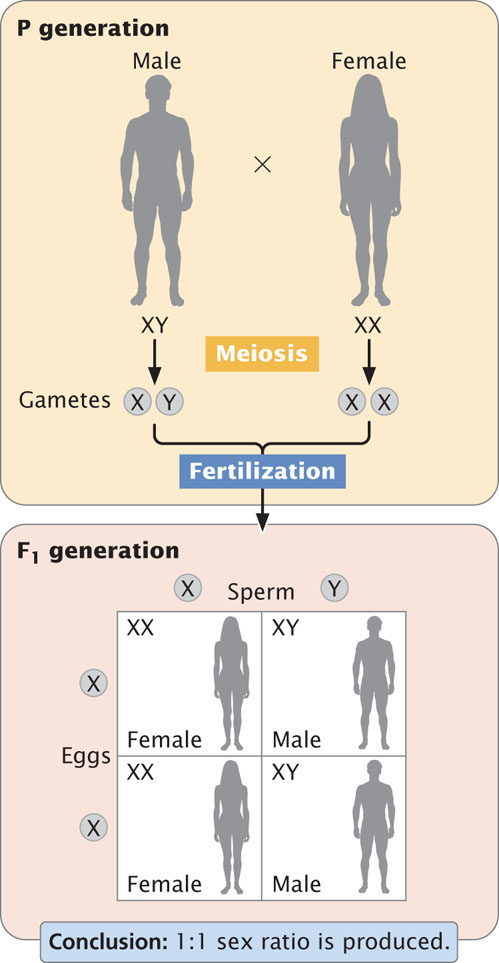
As Stevens and Wilson found for insects, sex in many organisms is determined by a pair of chromosomes, the sex chromosomes, which differ between males and females. The nonsex chromosomes, which are the same for males and females, are called autosomes. We think of sex in organisms with sex chromosomes as being determined by the presence of the sex chromosomes, but, in fact, the individual genes located on the sex chromosomes are usually responsible for the sexual phenotypes.
80
XX-XO Sex DeterminationThe mechanism of sex determination in the grasshoppers studied by McClung is one of the simplest mechanisms of chromosomal sex determination and is called the XX-XO system. In this system, females have two X chromosomes (XX), and males possess a single X chromosome (XO). There is no O chromosome—the letter O signifies the absence of a sex chromosome.
In meiosis in females, the two X chromosomes pair and then separate, with one X chromosome entering each haploid egg. In males, the single X chromosome segregates in meiosis to half the sperm cells; the other half receive no sex chromosome. Because males produce two different types of gametes with respect to the sex chromosomes, they are said to be the heterogametic sex. Females that produce gametes that are all the same with respect to the sex chromosomes are the homogametic sex. In the XX-XO system, the sex of an individual organism is therefore determined by which type of male gamete fertilizes the egg. X-bearing sperm unite with X-bearing eggs to produce XX zygotes, which eventually develop as females. Sperm lacking an X chromosome unite with X-bearing eggs to produce XO zygotes, which develop into males.
XX-XY Sex DeterminationIn many species, the cells of males and females have the same number of chromosomes, but the cells of females have two X chromosomes (XX) and the cells of males have a single X chromosome and a smaller sex chromosome, the Y chromosome (XY). In humans and many other organisms, the Y chromosome is acrocentric (Figure 4.6), not Y shaped as is often assumed. In this type of sex-determining system, the male is the heterogametic sex—half of his gametes have an X chromosome and half have a Y chromosome. The female is the homogametic sex—all her egg cells contain a single X chromosome. Many organisms, including some plants, insects, reptiles, and mammals (including humans) have the XX-XY sex-determining system. Other organisms have variations of the XX-XY system of sex determination, including the duck-billed platypus (discussed in the introduction to this chapter) in which females have five pairs of X chromosomes and males have five pairs of X and Y chromosomes.
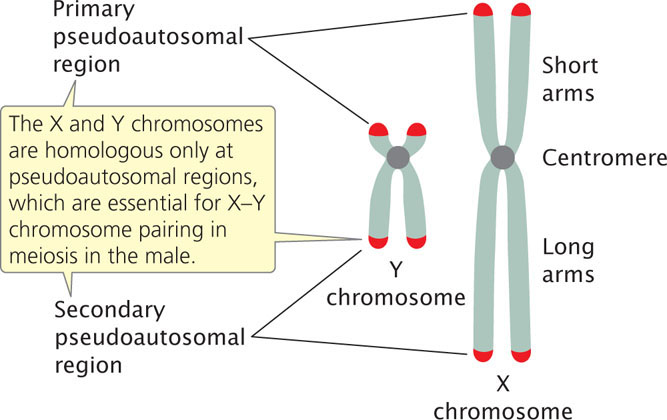
Although the X and Y chromosomes are not generally homologous, they do pair and segregate into different cells in meiosis. They can pair because these chromosomes are homologous in small regions called the pseudoautosomal regions (see Figure 4.6), in which they carry the same genes. In humans, there are pseudoautosomal regions at both tips of the X and Y chromosomes.
ZZ-ZW Sex DeterminationIn this system, the female is heterogametic and the male is homogametic. To prevent confusion with the XX-XY system, the sex chromosomes in this system are called Z and W, but the chromosomes do not resemble Zs and Ws. Females in this system are ZW; after meiosis, half of the eggs have a Z chromosome and the other half have a W chromosome. Males are ZZ; all sperm contain a single Z chromosome. The ZZ-ZW system is found in birds, snakes, butterflies, some amphibians, and some fishes.
81
CONCEPTS
The discovery that the presence or absence of particular chromosomes determines sex in insects provided evidence that genes are located on chromosomes. In XX-XO sex determination, the male is XO and heterogametic, and the female is XX and homogametic. In XX-XY sex determination, the male is XY and the female is XX; in this system, the male is heterogametic. In ZZ-ZW sex determination, the female is ZW and the male is ZZ; in this system, the female is the heterogametic sex.
 CONCEPT CHECK 2
CONCEPT CHECK 2
How does the heterogametic sex differ from the homogametic sex?
- The heterogametic sex is male; the homogametic sex is female.
- Gametes of the heterogametic sex have different sex chromosomes; gametes of homogametic sex have the same sex chromosome.
- Gametes of the heterogametic sex all contain a Y chromosome; gametes of the homogametic sex all contain an X chromosome.
Genic Sex Determination
In some organisms, sex is genetically determined, but there are no obvious differences in the chromosomes of males and females: there are no sex chromosomes. These organisms have genic sex determination; genotypes at one or more loci determine the sex of an individual. Scientists have observed genic sex determination in some plants, fungi, protozoans, and fish.
It is important to understand that, even in chromosomal sex-determining systems, sex is actually determined by individual genes. For example, in mammals, a gene (SRY, discussed later in this chapter) located on the Y chromosome determines the male phenotype. In both genic sex determination and chromosomal sex determination, sex is controlled by individual genes; the difference is that, with chromosomal sex determination, the sex chromosomes also look different in males and females.
Environmental Sex Determination
Genes have had a role in all of the examples of sex determination discussed thus far, but in a number of organisms, sex is determined fully or in part by environmental factors.
A fascinating example of environmental sex determination is seen in the marine mollusk Crepidula fornicata, also known as the common slipper limpet (Figure 4.7). Slipper limpets live in stacks, one on top of another. Each limpet begins life as a swimming larva. The first larva to settle on a solid, unoccupied substrate develops into a female limpet. It then produces chemicals that attract other larvae, which settle on top of it. These larvae develop into males, which then serve as mates for the limpet below. After a period of time, the males on top develop into females and, in turn, attract additional larvae that settle on top of the stack, develop into males, and serve as mates for the limpets under them. Limpets can form stacks of a dozen or more animals; the uppermost animals are always male. This type of sexual development is called sequential hermaphroditism; each individual animal can be both male and female, although not at the same time. In Crepidula fornicata, sex is determined environmentally by the limpet’s position in the stack.

Environmental factors are also important in determining sex in some reptiles; the sexual phenotype of many turtles, crocodiles, alligators, and a few birds is affected by temperature during embryonic development. In turtles, for example, warm incubation temperatures produce more females, whereas cool temperatures produce males. In alligators, the reverse is true. In some species, sex chromosomes usually determine whether individuals are male or female; however, sometimes environmental factors can override this chromosomal sex determination. For example, bearded dragon lizards are normally ZZ when male, and ZW when female, but when the eggs are incubated at high temperatures, ZZ individuals develop as phenotypic females. Some of the different types of sex determination are summarized in Table 4.1.
82
| System | Mechanism | Heterogametic Sex | Organisms | |
|---|---|---|---|---|
| XX-XO | Females XX | Males X | Male | Some grasshoppers and other insects |
| XX-XY | Females XX | Males XY | Male | Many insects, fish, amphibians, reptiles; mammals, including humans |
| ZZ-ZW | Females ZW | Males ZZ | Female | Butterflies, birds; some reptiles and amphibians |
| Genic sex determination | No distinct sex chromosomes Sex determined by genes on undifferentiated chromosomes | Varies | Some plants, fungi, protozoans, and fish | |
| Environmental sex determination | Sex determined by environmental factors | None | Some invertebrates, turtles, alligators | |
Now that we have surveyed some of the different ways in which sex can be determined, we will examine one mechanism (the XX-XY system) in detail. Sex determination is XX-XY in both fruit flies and humans but, as we will see, the way in which the X and Y chromosomes determine sex in these two organisms is quite different.  TRY PROBLEMS 4 AND 21
TRY PROBLEMS 4 AND 21
CONCEPTS
In genic sex determination, sex is determined by genes at one or more loci, but there are no obvious differences in the chromosomes of males and females. In environmental sex determination, sex is determined fully or in part by environmental factors.
 CONCEPT CHECK 3
CONCEPT CHECK 3
How do chromosomal, genic, and environmental sex determination differ?
Sex Determination in Drosophila melanogaster
The fruit fly Drosophila melanogaster has eight chromosomes: three pairs of autosomes and one pair of sex chromosomes. Usually, females have two X chromosomes and males have an X chromosome and a Y chromosome. In the 1920’s Calvin Bridges proposed that sex in Drosophila was determined, not by the number of X and Y chromosomes, but rather by the balance of female-determining genes on the X chromosome and male-determining genes on the autosomes. He suggested that a fly’s sex is determined by the so-called X : A ratio, the number of X chromosomes divided by the number of haploid sets of autosomal chromosomes. Normal flies possess two haploid sets of autosomes, and either two X-chromosomes (females), or one X chromosome and a Y chromosome (males). Bridges proposed that an X : A ratio of 1.0 produces a female fly; an X : A ratio of 0.5 produces a male fly. He also suggested that an X : A ratio between 1.0 and 0.5 produces an intersex fly, with a mixture of male and female characteristics. An X : A ratio less than 0.5 and greater than 1.0 produces developmentally abnormal flies called metamales and metafemales respectively. When Bridges and others examined flies with different numbers of sex chromosomes and autosomes, the X : A ratio appeared to correctly predict the phenotypic sex of the flies (Table 4.2).
| Sex-Chromosome Complement | Haploid Sets of Autosomes | X : A Ratio | Sexual Phenotype |
|---|---|---|---|
| XX | AA | 1.0 | Female |
| XY | AA | 0.5 | Male |
| XO | AA | 0.5 | Male |
| XXY | AA | 1.0 | Female |
| XXX | AA | 1.5 | Metafemale |
| XXXY | AA | 1.5 | Metafemale |
| XX | AAA | 0.67 | Intersex |
| XO | AAA | 0.33 | Metamale |
| XXXX | AAA | 1.3 | Metafemale |
83
Although the X : A ratio correctly predicts the sexual phenotype, recent research suggests that the mechanism of sex determination is not a balance between X-linked genes and autosomal genes, as Bridges proposed. Researchers have located a number of genes on the X chromosome that affect sexual phenotype, but few autosomal sex determining genes (required for the X : A ratio hypothesis) have been identified. New evidence suggests that genes on the X chromosome are the primary sex determinant. The influence of the number of autosomal chromosomes on sex is indirect, affecting the timing of developmental events and therefore how long sex-determining genes on the X chromosome are active. For example, XX flies with three autosomal sets (XX, AAA) have an X : A ratio of 0.67 and develop an intersex phenotype. In these flies, the presence of three autosomal sets causes a critical developmental stage to shorten, not allowing female factors encoded on the X chromosomes enough time to accumulate, with the result that the flies end up with an intersex phenotype. The number of autosomal chromosomes influences sex determination in Drosophila, but not through the action of autosomal genes as envisioned by Bridges.
CONCEPTS
Although the sexual phenotype of a fruit fly is predicted by the X : A ratio, sex is actually determined by genes on the X chromosome.
Sex Determination in Humans
Humans, like Drosophila, have XX-XY sex determination, but, in humans, the presence of a gene (SRY) on the Y chromosome determines maleness. The phenotypes that result from abnormal numbers of sex chromosomes, which arise when the sex chromosomes do not segregate properly in meiosis or mitosis, illustrate the importance of the Y chromosome in human sex determination.
Turner SyndromePersons who have Turner syndrome are female and often have underdeveloped secondary sex characteristics. This syndrome is seen in 1 of 3000 female births. Affected women are frequently short and have a low hairline, a relatively broad chest, and folds of skin on the neck. Their intelligence is usually normal. Most women who have Turner syndrome are sterile. In 1959, Charles Ford used new techniques to study human chromosomes and discovered that cells from a 14-year-old girl with Turner syndrome had only a single X chromosome (Figure 4.8); this chromosome complement is usually referred to as XO.
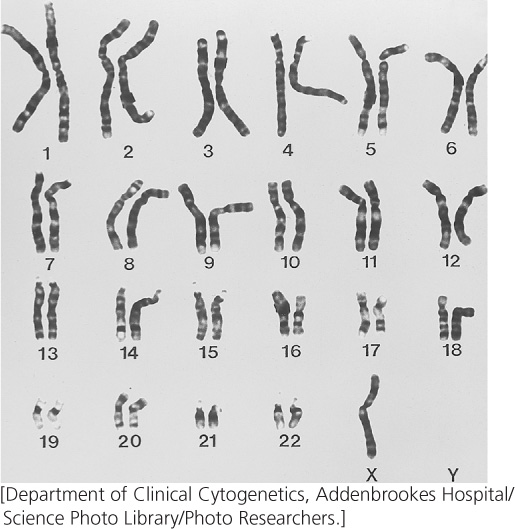
There are no known cases in which a person is missing both X chromosomes, an indication that at least one X chromosome is necessary for human development. Presumably, embryos missing both Xs spontaneously abort in the early stages of development.
Klinefelter SyndromePersons who have Klinefelter syndrome, which has a frequency of about 1 in 1000 male births, have cells with one or more Y chromosomes and multiple X chromosomes. The cells of most males having this condition are XXY (Figure 4.9), but the cells of a few Klinefelter males are XXXY, XXXXY, or XXYY. Men with this condition frequently have small testes and reduced facial and pubic hair. They are often taller than normal and sterile; most have normal intelligence.
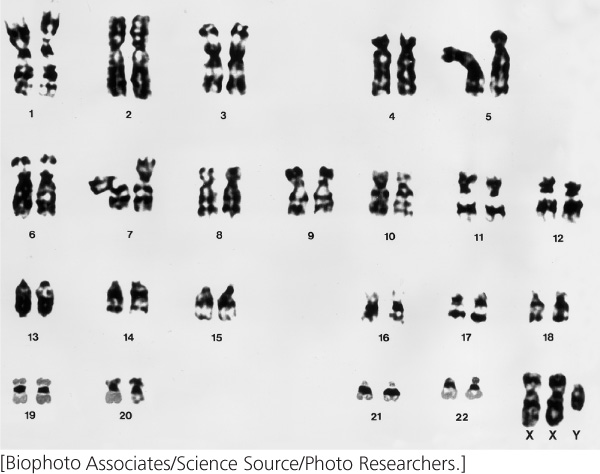
Poly-X FemalesIn about 1 in 1000 female births, the infant’s cells possess three X chromosomes, a condition often referred to as triple-X syndrome. These persons have no distinctive features other than a tendency to be tall and thin. Although a few are sterile, many menstruate regularly and are fertile. The incidence of intellectual disability among triple-X females is slightly greater than that in the general population, but most XXX females have normal intelligence. Much rarer are females whose cells contain four or five X chromosomes. These females usually have normal female anatomy but are intellectually disabled and have a number of physical problems. The severity of intellectual disability increases as the number of X chromosomes increases beyond three.
84
The Role of Sex ChromosomesThe phenotypes associated with sex-chromosome anomalies allow us to make several inferences about the role of sex chromosomes in human sex determination.
- 1. The X chromosome contains genetic information essential for both sexes; at least one copy of an X chromosome is required for human development.
- 2. The male-determining gene is located on the Y chromosome. A single copy of this chromosome, even in the presence of several X chromosomes, usually produces a male phenotype.
- 3. The absence of the Y chromosome usually results in a female phenotype.
- 4. Genes affecting fertility are located on the X and Y chromosomes. A female usually needs at least two copies of the X chromosome to be fertile.
- 5. Additional copies of the X chromosome may upset normal development in both males and females, producing physical and mental problems that increase as the number of extra X chromosomes increases.
The Male-Determining Gene in HumansThe Y chromosome in humans and all other mammals is of paramount importance in producing a male phenotype. However, scientists discovered a few rare XX males whose cells apparently lack a Y chromosome. For many years, these males presented an enigma: How could a male phenotype exist without a Y chromosome? Close examination eventually revealed a small part of the Y chromosome attached to another chromosome. This finding indicates that it is not the entire Y chromosome that determines maleness in humans; rather, it is a gene on the Y chromosome.
Early in development, all humans possess undifferentiated gonads and both male and female reproductive ducts. Then, about 6 weeks after fertilization, a gene on the Y chromosome becomes active. This gene causes the neutral gonads to develop into testes, which begin to secrete two hormones: testosterone and Mullerian-inhibiting substance. Testosterone induces the development of male characteristics, and Mullerian-inhibiting substance causes the degeneration of the female reproductive ducts. In the absence of this male-determining gene, the neutral gonads become ovaries, and female features develop.
The male-determining gene in humans, called the sex-determining region Y (SRY) gene, was discovered in 1990 (Figure 4.10). This gene is found in XX males and is missing from XY females; it is also found on the Y chromosome of other mammals. Definitive proof that SRY is the male-determining gene came when scientists placed a copy of this gene into XX mice by means of genetic engineering. The XX mice that received this gene, although sterile, developed into anatomical males.
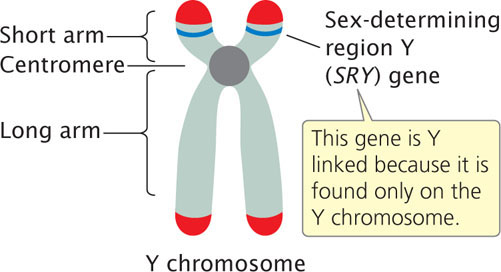
The SRY gene encodes a protein called a transcription factor (see Chapter 13) that binds to DNA and stimulates the transcription of other genes that promote the differentiation of the testes. Although SRY is the primary determinant of maleness in humans, other genes (some X linked, others Y linked, and still others autosomal) also have roles in fertility and the development of sex differences.
CONCEPTS
The presence of the SRY gene on the Y chromosome causes a human embryo to develop as a male. In the absence of this gene, a human embryo develops as a female.
 CONCEPT CHECK 4
CONCEPT CHECK 4
What is the phenotype of a person who has XXXY sex chromosomes?
- Klinefelter syndrome
- Turner syndrome
- Poly-X female
Androgen-Insensitivity SyndromeAlthough the SRY gene is the primary determinant of sex in human embryos, several other genes influence sexual development, as illustrated by women with androgen-insensitivity syndrome. These persons have female external sexual characteristics. Indeed, most are unaware of their condition until they reach puberty and fail to menstruate. Examination by a gynecologist reveals that the vagina ends blindly and that the uterus, oviducts, and ovaries are absent. Inside the abdominal cavity, a pair of testes produce levels of testosterone normally seen in males. The cells of a woman with androgen-insensitivity syndrome contain an X and a Y chromosome.
How can a person be female in appearance when her cells contain a Y chromosome and she has testes that produce testosterone? The answer lies in the complex relation between genes and sex in humans. In a human embryo with a Y chromosome, the SRY gene causes the gonads to develop into testes, which produce testosterone. Testosterone stimulates embryonic tissues to develop male characteristics. But, for testosterone to have its effects, it must bind to an androgen receptor. This receptor is defective in females with androgen-insensitivity syndrome; consequently, their cells are insensitive to testosterone, and female characteristics develop. The gene for the androgen receptor is located on the X chromosome, so persons with this condition always inherit it from their mothers.
85
Androgen-insensitivity syndrome illustrates points about the influence of genes on a person’s sex. First, this condition demonstrates that human sexual development is a complex process, influenced not only by the SRY gene on the Y chromosome, but also by other genes found elsewhere. Second, it shows that most people carry genes for both male and female characteristics, as illustrated by the fact that those with androgen-insensitivity syndrome have the capacity to develop female characteristics, even though they have male chromosomes. Indeed, the genes for most male and female secondary sex characteristics are present not on the sex chromosomes but on autosomes. The key to maleness and femaleness lies not in the genes but in the control of their expression.  TRY PROBLEM 17
TRY PROBLEM 17